X. Beharry1, V. Këpuska1, S. F. Powers2
1Florida Institute of Technology, ECE Department, Melbourne, Florida
2Harris Corporation, Melbourne, Florida
Correspondence to: S. F. Powers, Harris Corporation, Melbourne, Florida.
| Email: |  |
Copyright © 2012 Scientific & Academic Publishing. All Rights Reserved.
Abstract
This article introduces the concept of the Phoning Home System. It is a system that allows users to interact with their household appliances via the telephone, wherever they may be (e.g., driving). The Phoning Home System is able to monitor and reduce energy consumption by said appliances without encroaching on users’ convenience. While privacy can be seen as a major challenge to this eco-friendly project, its benefits far outweigh its limitations. The Phoning Home System encourages conservation through convenience and takes us one step closer to a greener tomorrow.
Keywords:
Phoning Home, Phantom Load, Energy Conservation, Convenience
Cite this paper: X. Beharry, V. Këpuska, S. F. Powers, Phoning Home: Bridging the Gap between Conservation and Convenience, Software Engineering, Vol. 2 No. 1, 2012, pp. 1-6. doi: 10.5923/j.se.20120201.01.
1. Introduction
In the past 10 years the United States has seen a rapid increase in its energy usage. (U.S. Department of Energy, 2010). During this time, both the Government and Private Sector have promoted a movement which aims to reduce energy consumption. Despite the specific push to reduce energy consumption, the need for energy continues to rise annually because the nation continues to choose convenience over conservation. “Many people’s concerns about energy are simply not strong enough, relative to their other concerns, to warrant learning about energy conservation.” (Attari, Dekay, Davidson, & Bruine de Bruin, 2010). If, as a nation, many are unwilling to even learn about conservation, fewer yet will actively work toward it.A survey examining households’ total daily energy consumption, conducted by the University of Oregon, published in 2009, reported 89% of participants did not unplug their printers after use as they found the task too inconvenient (Dawson & Potter, 2009). For these participants the concern for conservation did not trump their desire for convenience. The Phoning Home System is a potential solution to bridge the gap between conservation and convenience. The Phoning Home System provides the convenience of remotely controlling common household appliances via the telephone. Users call a virtual phone number which is linked, through a database, to their home. Callers speak naturally and issue commands which are interpreted by a speech recognition application and then executed accordingly.Through Voice we are able to provide a convenience of controlling the circumstances when a user is not in a position to perform the required operation (e.g., driving). In the Figure 1 presented below, a communication device used as a prototype for demonstrating our work is depicted.The Phoning Home System is able to turn off appliances by simply stopping the flow of electricity to that appliance by means of a specialized device; A Wireless Appliance Reducing Energy (A.W.A.R.E.). The architecture of the system promotes conservation in that it can be used to eliminate unnecessary power consumption primarily during periods when users are not at home. 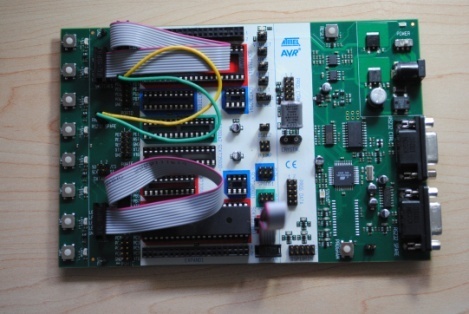 | Figure 1. STK500 Setup highlighting the RS232 port that is used for communicating with the computer |
Unnecessary power consumption is comprised of electronic devices which are left on when not in use, as well as appliances with a stand-by power mode, also known as a phantom load. An example of the former is a lit bulb when no one is home. The latter can be exemplified by a television which continually draws power while in stand-by mode as it awaits a signal from the user. According to the Lawrence Berkley National Laboratory, “phantom load” refers to “electricity used by appliances and equipment while they are turned off or not performing their primary function.” (Lawrence Berkly NationalLaboratory, 2009)The Phoning Home System provides an easy way to conserve finite resources. It does not require a major behavioral change on the part of the user nor does it require costly installation fees that usually accompany smart home upgrades. The following sections describe: the most up-to-date picture of general energy consumption in the United States is described in the section 0. In the section 0 the problem of the phantom load is presented. The proposed solution, Phoning Home System is given in the section 0. Given the present state of technology some potential drawbacks regarding the privacy issues are being addressed in the section finally the concluding remarks and future work is presented in the section.
2. General Energy Consumption in the United States
According to the U.S. Energy Information Administration, the United States has seen a rapid increase in its power consumption over the past 10 years. Within recent years, both the Government and the Private Sector have embarked on a movement to curtail energy and power consumption. This movement is fueled by the fact that non-renewal resources are being used up at an alarming rate to meet consumer demand.Figure 2 provides further insight to how power is being consumed within the residential sector. It can be seen that appliances, computers, electronics, lighting and space heating account for approximately 60% of the power consumed. Reducing the consumption in any of these areas will result in significant savings.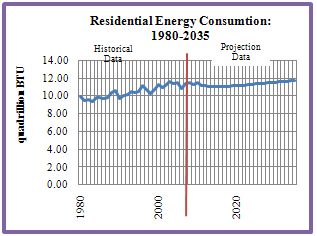 | Figure 2. Residential Energy Consumption for the period of 1980 to 2035. Source: U.S. Energy Information Administration, AEO2011 Early Release Overview (February, 2011) |
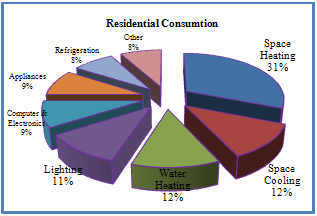 | Figure 3. Energy Consumption in the home. Source: U.S. Department of Energy (October, 2010) |
3. Phantom Loads
According to the Lawrence Berkley National Laboratory, “phantom loads”, also denoted as “standby power” or “vampire loads”, refer to electricity used by appliances and equipment while they are turned off or not performing their primary function (Lawrence Berkly National Laboratory, 2009). The Laboratory estimates that phantom loads account for 5-10% of residential electricity use in most developed countries and is rising in developing countries. It is estimated that “standby power” or these “phantom loads” are responsible for 1% of the global carbon dioxide emissions (Lawrence Berkly National Laboratory, 2009) Therefore reducing phantom loads is one of the easiest ways to reduce residential energy consumption and increase savings without inconveniencing members of a household.
4. The Proposed Solution
In an attempt to bridge the gap between conservation and convenience the Phoning Home System was conceived. It conserves energy by eliminating all power to an appliance when not in use. It is convenient because the user can interact with their appliances by simply placing a phone call to their home and speaking naturally to their appliances. Users would be able to interact with their appliance from any physical location in the world provided that they had access to a telephone. At home they need to use their speech or or resort to more conventional GUI interfaces provided by G3 or G4 smartphones. | Figure 4. The Proposed Solution that will bridge the gap between Conservation and conveniences |
Table 1. Cost of Phantom Loads. Source: Rochester Public Utility (2009)
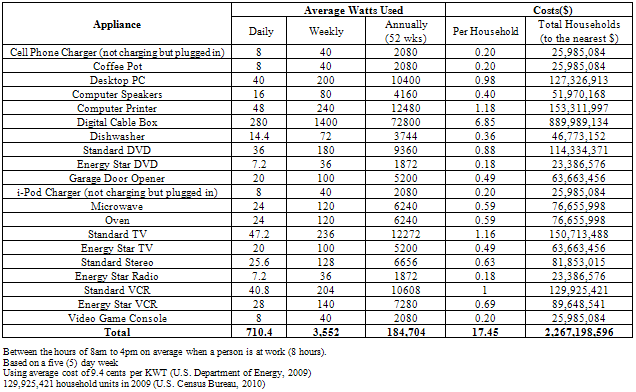 |
| |
|
4.1. Phoning Home Framework
The main entry point into the system can be any telephone, landline or mobile phone. The system is made accessible through a virtual phone number provisioned by the Asterisk Phone Server Application (PSA). This application accepts incoming calls and records the user’s voice commands. The Phone Server Application then passes the audio to the Speech Recognition Application for processing.The communication between the user’s phone and the Asterisk Phone Server Application is depicted in the Figure 5 below. | Figure 5. Asterisk communication with HTTP server |
Step 1 - SessionA user makes a call using the virtual number to the Asterisk server. Asterisk creates a web session with a request to the desired HTTP server. This HTTP server contains the resources for handling the phone call. This session contains a wealth of information including the unique identification number for the newly created session which can be used for tracking and log keeping. The session variables are used to route the call appropriately.Step 2 – Response to AsteriskOnce the session information has been successfully received by the HTTP server it responds to the Asterisk server with a JavaScript Object Notation (JSON) document that contains the desired behavior. This includes but is not limited to prompting the user for voice input, playing a tone, or capturing. The JSON document is a script containing the instructions to the Asterisk server as to how to handle the current call.Note. JSON is a lightweight data inter-chance format. It is easy for humans to read and write. It is easy for machines to generate. It is based on a subset of JavaScript Programming Language, Standard ECMA-262 3rd Edition – December 1999. It is a text format that is completely language independent but uses conventions that are familiar to programmers of the C-family of languages.Step 3 – Asterisk ResultAfter executing the instructions returned by the HTTP server, Asterisk will return the information to the HTTP server as a result document.Step 4 – Process & Hang UpThe HTTP server will process the obtained results. It can choose to interact with the Asterisk server again or it can choose to end the session. If the HTTP server makes no further requests, the Asterisks server ends the session and the call is hung up. The Speech Recognition Application (SRA) accepts and stores the audio data before passing it through its speech recognition engine. The engine is built with Carnegie Mellon University’s (CMU) Sphinx-4 Open Source Speech Recognition Project. The recognition process converts the voice commands into commands that the computer can understand. These commands are used to update the Phoning Home Database which contains the current state of the user’s household devices. (The state of the device refers to whether the device should be on or off for example.) Once the Phoning Home Database has been successfully updated the SRA contacts the Master Control (MC) with the updated devices’ states. The MC and the SRA communicate over the internet through the Client Services. The Client Services act as the communication channel for information passing to and from the SRA to a specific Master Control within a user’s home.The MC communicates with each of the Phoning Home Devices over a wireless connection. It constantly monitors the health, usage and status of the devices. The MC consists of reliable, high performance microcontrollers that features low power consumption.The Client Side Application is a simple but effective Graphical User Interface (GUI) that provides a visual representation of the status of the Phoning Home System. Through the GUI, users can view and set individual device states (on/off, temperature, etc.). Users are no longer constrained by the physical limitations of hardware design. By utilizing software GUIs users can now interact with their appliances using clear and concise virtual controls. The overall system and its modules is provided in the figure below.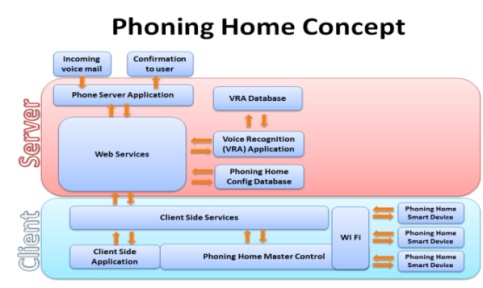 | Figure 6. Phoning Home Framework. The communication between the modules of the Phoning Home system |
The Phoning Home System Concept attempts to bring convenience closer to conservation. By automating simple tasks such as switching on or off an appliance when not in use, we are able to make relatively small cutbacks on an individual level. However, collectively this can contribute significantly towards the efforts of reducing consumption and conserving energy.The overall sequence diagram of the Phoning Home System is provided  | Figure 7. Phoning Home Sequence Diagram Depicting the messages interacting with the Phoning Home Components |
4.2. Master Control & A.W.A.R.E Devices
The Phoning Home Master Control (MC) is an external device that communicates with the client services to obtain the desired states of all the individual devices connected within the home. In the Figure 1 above a device that was used to simulate the Master Control is presented. On the simplest level the MC would act as a digital switch to power strips and electrical outlets; see for example Figure 8 below. This would eliminate the phantom load pulled by a cluster of appliances when not in use. Since the individual device states are stored in a database, it would be relatively easy to automate the process of switching off appliances during known times of non-use. This kind of functionality was implemented using our demonstration. | Figure 8. Master Control switches the powerstrip off during periods of non-use to eliminate phantom load on the cluster of appliances |
The Figure 9 below depicts “A Wireless Appliance Reducing Energy” or AWARE power-strip interacting with the Master Control. Using wireless devices to communicate with the Master Control is very appealing because it does not restrict the physical location of the appliances that are to be controlled. In other words, the user is free to place appliances wherever they deem appropriate preserving the user’s sense of convenience. This functionality will be developed in the very near future. | Figure 9. Master Control communicating with A Wireless Appliance Reducing Energy (A.W.A.R.E.) Any appliance with a clock can now be completely switched off and upon repowering the device; it is able to retrieve the current time from the server |
Both the Master Control and the A.W.A.R.E. devices can be each powered by either a battery or an external power supply of 3.3 to 5 volt DC assuming they are running with an 8Mhz core clock. They typically consume no more than 200mA during operation. The average power consumption is less than 3 Watts per hour. See Table 2 below for further details.Note: The power consumption by both devices can be further reduced by optimizing the code to run at slower clock speeds.Table 2. Electrical Characteristics of the Master Control
 |
| |
|
5. Potential Drawbacks
Factors such as out of service internet networks and unavailable telephone carriers threaten the functionality of the Phoning Home System. Users will be unable to communicate with their homes if any of the above named networks fail. Another major threat to the system is the possibility of a hijacked (unauthorized access to information passing to and from the A.W.A.R.E. devices) wireless network. If the wireless network is compromised, unauthorized individuals may gain control over devices.Individual A.W.A.R.E. devices report their usage and health to the server which processes and build usage patterns for individual homes. This information can be abused and used to invade an individual’s privacy. The usage patterns can be transformed into user-profiles. These user-profiles would provide detailed insight into a user’s routine when at home.
6. Conclusions
Within recent years both the Government and the Private Sector have embarked on an initiative to educate the public about the importance of using energy conservatively. While these messages are abundant, the population has been slow to give up old habits (e.g. unplugging appliances, turning off lights, changing thermostat settings, etc.) and adopt conservative practices. These habits remain because there is a lack of financial incentive and also because change requires effort. This effort is seen as inconvenient.The Phoning Home system attempts to conserve energy, conveniently. An integral part of the system is the utilization of A.W.A.R.E devices. These wireless devices are used to completely terminate the power to appliances when not in use. This eliminates phantom load or standby power.The Phoning Home System is not without its weaknesses. Unauthorized access to the Phoning Home Database could be used to create more precise “energy profiles” of homes and could be considered to be an invasion of privacy.In conclusion, the Phoning Home System’s strengths outweigh its weaknesses. It has the potential for residential as well as industrial use. The Phoning Home System encourages conservation through convenience and takes us one step closer to a greener tomorrow.
References
| [1] | Lawrence Berkly National Laboratory. (2009). What exactly is standby power and why is it necessary? Retrieved 10 18, 2010 ,from http://standby.lbl.gov/faq.html |
| [2] | Attari, S., Dekay, M., Davidson, C., & Bruine de Bruin, W. (2010). Public perceptions of energy consumption and savings. Proceedings of the National Academy of Sciences. |
| [3] | Dawson, E., & Potter, J. (2009). Are Phantom LoadsHaunting Your Energy Bill? University of Oregon |
| [4] | Booklet: Tips on Saving Energy & Money at Home.http://www.energysavers.gov/pdfs/energy_savers.pdf |









 Abstract
Abstract Reference
Reference Full-Text PDF
Full-Text PDF Full-text HTML
Full-text HTML

